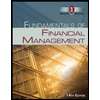
Concept explainers
Estimating Exxon Mobil Corporation's Intrinsic Stock Value
Use online resources to work on this chapter's questions. Please note that website information changes over time, and these changes may limit your ability to answer some of these questions.
In this chapter, we described the various factors that influence stock prices and the approaches that analysts use to estimate a stock’s intrinsic value. By comparing these intrinsic value estimates to the current price, an investor can assess whether it makes sense to buy or sell a particular stock. Stocks trading at a price far below their estimated intrinsic values may be good candidates for purchase, whereas stocks trading at prices far in excess of their intrinsic value may be good stocks to avoid or sell Although estimating a stock's intrinsic value is a complex exercise that requires reliable data and good judgment, we can use the Internet to find financial data in order to arrive at a quick "back-of-the- envelope" calculation of intrinsic value.
5. To put the firm's current P/E ratio in perspective, it is useful to compare this ratio with that of other companies in the same industry. To see how XOM’s P/E ratio stacks up to its peers, refer to Google Finance's Related Companies screen. (If you click "Add or remove columns,” you will find that you can obtain comparisons of a number of key statistics for either the most recent year or quarter) For the most part, is XOM's P/E ratio above or below that of its peers? In Chapter -4, we discussed the various factors that may influence P/E ratios Can any of these factors explain why XOM's P/E ratio differs from its peers? Explain.
Want to see the full answer?
Check out a sample textbook solution
Chapter 9 Solutions
Bundle: Fundamentals Of Financial Management, Loose-leaf Version, 15th + Mindtapv2.0 Finance, 1 Term (6 Months) Printed Access Card
- What is the value at the end of year 3 of a perpetual stream of $70,000 semi-annual payments that begins at the end of year 7? The APR is 12% compounded quarterly.arrow_forwardFirm A must pay $258,000 to firm B in 10 years. The discount rate is 16.44 percent per year. What is the present value of the cash flow associated with this arrangement for firm A? -I got the answer of 56331.87773=56332 (rounded to the nearest dollar), but it says incorrect.arrow_forwardSuppose you have two histograms: one where the mean equals the median, and one where the mean is different from the median. How would you expect the two histograms to differ.arrow_forward
 Fundamentals of Financial Management (MindTap Cou...FinanceISBN:9781285867977Author:Eugene F. Brigham, Joel F. HoustonPublisher:Cengage Learning
Fundamentals of Financial Management (MindTap Cou...FinanceISBN:9781285867977Author:Eugene F. Brigham, Joel F. HoustonPublisher:Cengage Learning Fundamentals of Financial Management (MindTap Cou...FinanceISBN:9781337395250Author:Eugene F. Brigham, Joel F. HoustonPublisher:Cengage Learning
Fundamentals of Financial Management (MindTap Cou...FinanceISBN:9781337395250Author:Eugene F. Brigham, Joel F. HoustonPublisher:Cengage Learning EBK CONTEMPORARY FINANCIAL MANAGEMENTFinanceISBN:9781337514835Author:MOYERPublisher:CENGAGE LEARNING - CONSIGNMENT
EBK CONTEMPORARY FINANCIAL MANAGEMENTFinanceISBN:9781337514835Author:MOYERPublisher:CENGAGE LEARNING - CONSIGNMENT- Principles of Accounting Volume 1AccountingISBN:9781947172685Author:OpenStaxPublisher:OpenStax College
 Fundamentals Of Financial Management, Concise Edi...FinanceISBN:9781337902571Author:Eugene F. Brigham, Joel F. HoustonPublisher:Cengage Learning
Fundamentals Of Financial Management, Concise Edi...FinanceISBN:9781337902571Author:Eugene F. Brigham, Joel F. HoustonPublisher:Cengage Learning Fundamentals of Financial Management, Concise Edi...FinanceISBN:9781285065137Author:Eugene F. Brigham, Joel F. HoustonPublisher:Cengage Learning
Fundamentals of Financial Management, Concise Edi...FinanceISBN:9781285065137Author:Eugene F. Brigham, Joel F. HoustonPublisher:Cengage Learning





